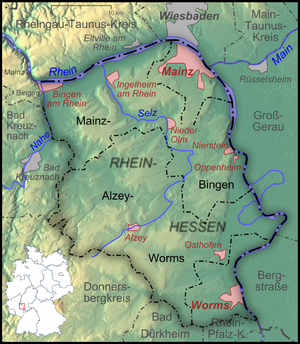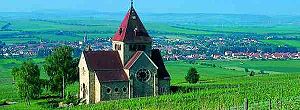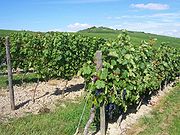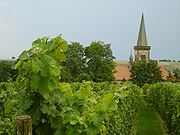
Rheinhessen (wine region)
Encyclopedia

West Bank (Rhine)
The West Bank was a landlocked territory and comprised the south western part of Germany and the Southern Netherlands on the west bank of the Rhine in Europe. To the east, the West Bank shared border with the Holy Roman Empire...
between Worms
Worms, Germany
Worms is a city in Rhineland-Palatinate, Germany, on the Rhine River. At the end of 2004, it had 85,829 inhabitants.Established by the Celts, who called it Borbetomagus, Worms today remains embattled with the cities Trier and Cologne over the title of "Oldest City in Germany." Worms is the only...
and Bingen
Bingen am Rhein
Bingen am Rhein is a town in the Mainz-Bingen district in Rhineland-Palatinate, Germany.The settlement’s original name was Bingium, a Celtic word that may have meant “hole in the rock”, a description of the shoal behind the Mäuseturm, known as the Binger Loch. Bingen was the starting point for the...
in the federal state of Rhineland-Palatinate
Rhineland-Palatinate
Rhineland-Palatinate is one of the 16 states of the Federal Republic of Germany. It has an area of and about four million inhabitants. The capital is Mainz. English speakers also commonly refer to the state by its German name, Rheinland-Pfalz ....
. Despite its historic name it is currently no longer part of the federal-state of Hesse
Hesse
Hesse or Hessia is both a cultural region of Germany and the name of an individual German state.* The cultural region of Hesse includes both the State of Hesse and the area known as Rhenish Hesse in the neighbouring Rhineland-Palatinate state...
, this being the case since the end of WWII. There have been several unsuccessful attempts to legally reunite the former wine growing districts of Mainz on the hessian side during the post-war area. Rheinhessen produces mostly white wine from a variety of grapes, particularly Müller-Thurgau
Müller-Thurgau
Müller-Thurgau is a variety of white grape which was created by Hermann Müller from the Swiss Canton of Thurgau in 1882. It is a crossing of Riesling with Madeleine Royale. It is used to make white wine in Germany, Austria, Northern Italy, Hungary, England, in Australia, Czech Republic, Slovakia,...
(4.320 ha), Riesling (3.769 ha) and Silvaner
Silvaner
Sylvaner or Silvaner is a variety of white wine grape grown primarily in Alsace and Germany, where its official name is Grüner Silvaner. In Germany it is best known as a component of Liebfraumilch and production boomed in the 1970s to the detriment of quality, but it has long enjoyed a better...
(2.467 ha), and is best known as the home of Liebfraumilch
Liebfraumilch
Liebfraumilch or Liebfraunmilch is a style of semi-sweet white German wine which may be produced, mostly for export, in the regions Rheinhessen, Palatinate, Rheingau and Nahe. The name is a German word literally meaning "Beloved lady's milk"...
, although some previously underrated Riesling
Riesling
Riesling is a white grape variety which originated in the Rhine region of Germany. Riesling is an aromatic grape variety displaying flowery, almost perfumed, aromas as well as high acidity. It is used to make dry, semi-sweet, sweet and sparkling white wines. Riesling wines are usually varietally...
s are also made, increasingly in a powerful dry style.
The wine region is member of the Great Wine Capitals Global Network.

Geography
The Rhine forms the eastern and northern boundary of the region, with the Nahe River to the west and the Haardt MountainsHaardt Mountains
The Haardt is a range of wooded, sandstone hills in the state of Rhineland Palatinate in southwestern Germany. The range is some long and lies within the Palatinate Forest . Its highest point is the Kalmit, near Maikammer, which stands above sea level....
to the south. The Palatinate wine region
Palatinate (wine region)
Palatinate is a German wine-growing region in the area of Bad Dürkheim, Neustadt an der Weinstraße, and Landau in Rhineland-Palatinate. Before 1993, it was known as Rhine Palatinate . With under cultivation in 2008, the region is the second largest wine region in Germany after Rheinhessen...
lies to the south, the Rheingau
Rheingau (wine region)
Rheingau is one of 13 German wine regions for quality wines . Named for the traditional region of Rheingau , the wine region is situated in the state of Hesse, where it makes up part of the Rheingau-Taunus-Kreis administrative district...
lies across the Rhine to the north, and the Nahe wine region
Nahe (wine region)
Nahe is a region for quality wine in Germany, along the River Nahe in the state of Rhineland-Palatinate. On the region's of vineyards in 2008, white wine grapes dominate with 75% and Riesling is the most common variety with 27.2%...
to the west. Known as the "land of the thousand hills", the terrain is undulating with vineyards mixed with orchards and other forms of farming. Its larger towns include: Mainz
Mainz
Mainz under the Holy Roman Empire, and previously was a Roman fort city which commanded the west bank of the Rhine and formed part of the northernmost frontier of the Roman Empire...
, Worms, Bingen, Alzey
Alzey
Alzey is a Verband-free town – one belonging to no Verbandsgemeinde – in the Alzey-Worms district in Rhineland-Palatinate, Germany. It is the fourth-largest town in Rhenish Hesse, after Mainz, Worms, and Bingen....
, Nieder-Olm
Nieder-Olm
Nieder-Olm is a town in the Mainz-Bingen district in Rhineland-Palatinate, Germany. Until 5 November 2006 it was an Ortsgemeinde – a municipality belonging to a Verbandsgemeinde, a kind of collective municipality – but it was raised to town the next day...
and Ingelheim.
In general the wines are best nearest the Rhine, where the soils impart more complex flavours. The best known area for white wines is the so-called Rhine Terrace (Rheinterasse; sometimes Rhine Front, Rheinfront) between Oppenheim
Oppenheim
Oppenheim is a town in the Mainz-Bingen district in Rhineland-Palatinate, Germany. The town is well known as a wine town, the site of the German Winegrowing Museum and particularly for the wines from the Oppenheimer Krötenbrunnen vineyards.- Location :...
and Nackenheim
Nackenheim
Nackenheim is an Ortsgemeinde – a municipality belonging to a Verbandsgemeinde, a kind of collective municipality – and a winegrowing centre in the Mainz-Bingen district in Rhineland-Palatinate, Germany.- Location :...
, which by itself is bigger than the whole of the Rheingau. A part of the Rhine Terrace, between Nackenheim and Nierstein
Nierstein
Nierstein is an Ortsgemeinde – a municipality belonging to a Verbandsgemeinde, a kind of collective municipality – in the Mainz-Bingen district in Rhineland-Palatinate, Germany.- Location :...
is known as the Red Slope (Roter Hang) because of the presence of red slate
Slate
Slate is a fine-grained, foliated, homogeneous metamorphic rock derived from an original shale-type sedimentary rock composed of clay or volcanic ash through low-grade regional metamorphism. The result is a foliated rock in which the foliation may not correspond to the original sedimentary layering...
. The main red grape area is around Ingelheim, in the north of the region opposite the Rheingau.
History

Ancient Rome
Ancient Rome was a thriving civilization that grew on the Italian Peninsula as early as the 8th century BC. Located along the Mediterranean Sea and centered on the city of Rome, it expanded to one of the largest empires in the ancient world....
times, and viticulture
Viticulture
Viticulture is the science, production and study of grapes which deals with the series of events that occur in the vineyard. When the grapes are used for winemaking, it is also known as viniculture...
was promoted by Charlemagne
Charlemagne
Charlemagne was King of the Franks from 768 and Emperor of the Romans from 800 to his death in 814. He expanded the Frankish kingdom into an empire that incorporated much of Western and Central Europe. During his reign, he conquered Italy and was crowned by Pope Leo III on 25 December 800...
.
When the owners of Stadecken-Elsheim
Stadecken-Elsheim
Stadecken-Elsheim is an Ortsgemeinde – a municipality belonging to a Verbandsgemeinde, a kind of collective municipality – in the Mainz-Bingen district in Rhineland-Palatinate, Germany.-Location:...
the Counts of Katzenelnbogen
Katzenelnbogen
Katzenelnbogen is the name of a castle and small city in the district of Rhein-Lahn-Kreis in Rhineland-Palatinate, Germany. Katzenelnbogen is the seat of the Verbandsgemeinde Katzenelnbogen.-History:...
first cultivated Riesling in 1435 they called the wine from this part of their county the Wine from the Gau. At the Congress of Vienna
Congress of Vienna
The Congress of Vienna was a conference of ambassadors of European states chaired by Klemens Wenzel von Metternich, and held in Vienna from September, 1814 to June, 1815. The objective of the Congress was to settle the many issues arising from the French Revolutionary Wars, the Napoleonic Wars,...
in 1814/15, Louis I, Grand Duke of Hesse
Louis I, Grand Duke of Hesse
Louis I, Grand Duke of Hesse was Landgrave of Hesse-Darmstadt and later the first Grand Duke of Hesse and by Rhine....
, was awarded with Rhenish Hesse as compensation for the loss of his Westphalian territories. As a result, he amended his title to "Grand Duke of Hesse and by Rhine" and the name of the region was created.
Liebfrauenmilch is named after the Liebfrauenkirche (Church of Our Lady) in Worms
Worms, Germany
Worms is a city in Rhineland-Palatinate, Germany, on the Rhine River. At the end of 2004, it had 85,829 inhabitants.Established by the Celts, who called it Borbetomagus, Worms today remains embattled with the cities Trier and Cologne over the title of "Oldest City in Germany." Worms is the only...
, which also was the name of a good and famous vineyard. Later, Liebfrauenmlich was used as a name for a semi-sweet wine style produced in several German regions, and became responsible for much of the erosion of the German wines' reputation on the export market. The most famous Liebfraumlich brand, until they changed their classification, was Blue Nun
Blue Nun
Blue Nun is a German wine brand launched by the company H. Sichel Söhne in 1923 with the 1921 vintage, and which between the 1950s and 1980s was probably the largest international wine brand. For most of its existence, Blue Nun was a single German wine, which until late 1990s was classified as a...
which was created in 1921. Today, no quality-oriented top producer in Rheinhessen would dare to produce a Liebfrauenmilch for fear of their reputation.
Grape varieties
On the 26,444 hectares (of Rheinhessen's vineyards as of 2008, white grape varieties account for 69%. After a period of increasing plantations of red grape varieties the balance between red and white varieties has been more stable in the last few years. Müller-ThurgauMüller-Thurgau
Müller-Thurgau is a variety of white grape which was created by Hermann Müller from the Swiss Canton of Thurgau in 1882. It is a crossing of Riesling with Madeleine Royale. It is used to make white wine in Germany, Austria, Northern Italy, Hungary, England, in Australia, Czech Republic, Slovakia,...
(usually labelled Rivaner when vinified dry), the prime ingredient in Liebfraumilch, is still the most grown with 16.3% of the area, although it has decreased significantly. Riesling
Riesling
Riesling is a white grape variety which originated in the Rhine region of Germany. Riesling is an aromatic grape variety displaying flowery, almost perfumed, aromas as well as high acidity. It is used to make dry, semi-sweet, sweet and sparkling white wines. Riesling wines are usually varietally...
, currently at 14.3%, has been increasing in the last few years. Among the red varieties, Dornfelder
Dornfelder
Dornfelder is a dark-skinned variety of grape of German origin used for red wine. It was created by August Herold at the grape breeding institute in Weinsberg in the Württemberg region in 1955. Herold crossed the grape varieties Helfensteiner and Heroldrebe, the latter which bears his name, to...
is the most planted at 13.0%, and it was Rheinhessen's second-most planted variety for a few years before being overtaken by Riesling in 2008. Silvaner
Silvaner
Sylvaner or Silvaner is a variety of white wine grape grown primarily in Alsace and Germany, where its official name is Grüner Silvaner. In Germany it is best known as a component of Liebfraumilch and production boomed in the 1970s to the detriment of quality, but it has long enjoyed a better...
at 9.3% is also widely planted, although it also has decreased significantly. Although in decline, Scheurebe
Scheurebe
Scheurebe or Sämling 88 is a white wine grape variety. It is primarily grown in Germany and Austria, where it often is called Sämling 88 , and some parts of the New World...
at 3.9% has a special connection to the region since Georg Scheu bred it at the Alzey Research Institute in the region.
The most cultivated grape varieties, by area in 2008, were:
|
Regent (grape) Regent is a dark-skinned inter-specific hybrid grape variety, used for making wine. It has both European and American vine species in its pedigree and a broad resistance against the most significant fungal diseases which affect grapes, such as downy mildew.Regent was created in 1967 by Professor... , 783 ha (3.0%) Faberrebe Faberrebe or Faber is a grape variety used for white wine. It was created in 1929 by Georg Scheu at the Landesanstalt für Rebenzüchtung in Alzey and was released with varietal protection in 1967. Scheu created Faberrebe by crossing Pinot Blanc and Müller-Thurgau... , 497 ha (1.9%) Huxelrebe Huxelrebe is a white grape used for wine. Huxelrebe is primarily found in Germany, where the cultivated area covered in 2006, with a decreasing trend. It is primarily found in the German wine regions Rheinhessen, Palatinate and Nahe. Small plantations are also found in England.- Properties... , 421 ha (1.6%) Chardonnay Chardonnay is a green-skinned grape variety used to make white wine. It is originated from the Burgundy wine region of eastern France but is now grown wherever wine is produced, from England to New Zealand... , 404 ha (1.5%) Ortega (grape) Ortega is a grape variety used for white wine. It was created in 1948 by Hans Breider at the Bayerischen Landesanstalt für Wein-, Obst- und Gartenbau in Würzburg and was released with varietal protection in 1981. It is a cross between Müller-Thurgau and Siegerrebe... , 355 ha (1.3%) Merlot Merlot is a darkly blue-coloured wine grape, that is used as both a blending grape and for varietal wines. The name Merlot is thought to derive from the Old French word for young blackbird, merlot, a diminutive of merle, the blackbird , probably from the color of the grape. Merlot-based wines... , 144 ha (0.5%) Sauvignon blanc Sauvignon Blanc is a green-skinned grape variety which originates from the Bordeaux region of France. The grape most likely gets its name from the French word sauvage and blanc due to its early origins as an indigenous grape in South West France., a possible descendant of savagnin... , 108 ha (0.4%) |
Styles
In the past, most of the wine had been cheap white wine that was off-dry to semi-sweet. The response to Liebfraumilch falling out of fashion was to market "Rheinhessen-Silvaner" as a dry wine, which wasn't a great success in regard to the export markets. Some dessert wines are made.Since more young winemakers get their oenological education at the renowned University of Applied Sciences in Geisenheim
Geisenheim
Geisenheim is a town in the Rheingau-Taunus-Kreis in the Regierungsbezirk of Darmstadt in Hessen, Germany, and is known as Weinstadt , Schulstadt , Domstadt and Lindenstadt ....
, the quality increases year by year. Nearly all styles of wine may be found, old fashioned as well as new techniques. Due to the competitive qualities at the yearly VDP wine market of the Verband Deutscher Prädikats- und Qualitätsweingüter
Verband Deutscher Prädikats- und Qualitätsweingüter
Verband Deutscher Prädikats- und Qualitätsweingüter e.V. or the Association of German Prädikat Wine Estates, is an organisation where most of Germany's top wine producers are members. It is commonly known under its acronym VDP...
held in Mainz, not all requests for the 2006 harvest could be granted.
Districts

Bingen
In the northwest, towards the Nahe river; Scharlachberg is an important vineyard. In the town, one of the most renowned Liebfraumilch, Black Tower, is created by the Reh-Kendermann winery.Rheinterrasse
Source of most of the interesting wines of the region, and home to a third of the Riesling. The Roter Hang (red slope) in the north of this area lies on a sandstone that is reputed to give the best wines, to the south the soils become deeper.Further reading
- Becht, Monika: Weinland Rheinhessen. (German) Frankfurt: Societäts-Verlag 2005. ISBN 3-7973-0936-8
- Mangold, Matthias F.: Rheinhessen im Glas. (German) Offenbach: Höma-Verlag 2006. ISBN 3937329145.
- Priewe, Jens: WEIN DIE NEUE GROSSE SCHULE (German) Zabert Sandmann 1997 ISBN 3-932023-02-1
External links
- winedoctor.com Good overview of the region, concentrating on the Rhine Terrace.
- Rheinhessen: Rediscovered German Wine Country, Color Magazine, May 2011
- (en) German wines
- (de) Rheinhessen wines
- (de) Wineries, Companies and wine festivals in Rheinhessen
- (en) list of Rheinhessen vineyards

